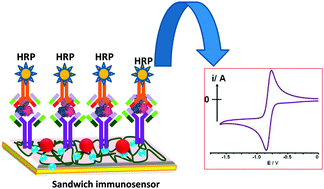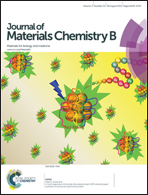A chitosan modified nickel oxide platform for biosensing applications†
Abstract
We present a highly sensitive and selective electrochemical sandwich immunosensor (the analyte is “sandwiched” between two antibodies) based on chitosan (CH) modified nickel oxide (NiO) nanoparticles for the detection of Vibrio cholerae (Vc). The primary monoclonal antibodies specific to Vibrio cholerae (Ab-Vc) and bovine serum albumin (BSA) were co-immobilized on a CH–NiO surface deposited onto an indium tin oxide (ITO) coated glass electrode. The specific binding of Ab-Vc towards Vc was confirmed by interaction of secondary antibodies conjugated with protein [horse radish peroxidase (HRP)], with varying concentrations of hydrogen peroxide (H2O2), via electrochemical as well as optical techniques. The CH–NiO/ITO and Ab-Vc/CH–NiO/ITO electrodes have been characterized using X-ray diffraction, Fourier transform infrared spectroscopy, scanning electron microscopy, high-resolution transmission electron microscopy and electrochemical techniques. This immunoelectrode (BSA/Ab-Vc/CH–NiO/ITO) exhibits a detection range of 20–700 ng mL−1 with a sensitivity of 0.644 μA ng mL−1 cm−2 and a low detection range of 0.108 ng mL−1 to Vc concentration. Besides this, the electrochemical response of the sandwich immunosensor (HRP–Ab-Vc/Vc/BSA/Ab-Vc/CH–NiO/ITO) towards H2O2 concentration is found to be linear in the range of 10–50 mM with excellent sensitivity (2.95 mA mM−1 cm−2).


 Please wait while we load your content...
Please wait while we load your content...